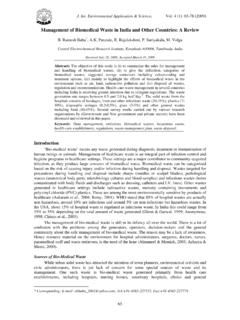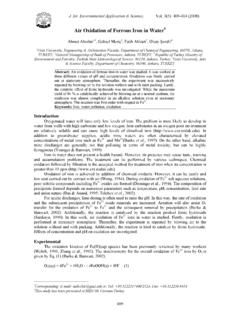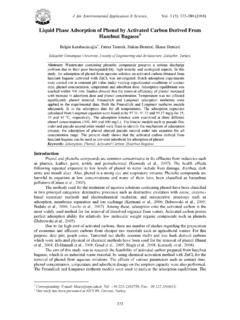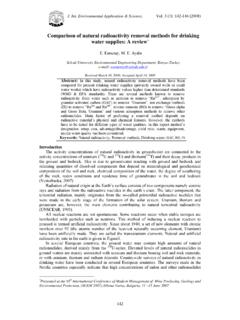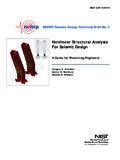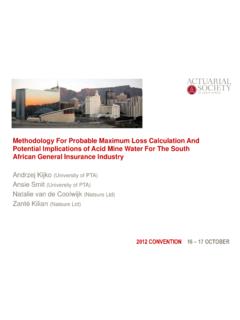Transcription of Seismotectonic Settings of Kosova - jieas.com
1 J. Int. Environmental Application & Science, Vol. 4 (2): 167-176 (2009) 167 Seismotectonic Settings of Kosova Zenun Elezaj University of Prishtina, Faculty of Mining and Geology, Mitrovice, Kosova Received: March 25, 2009; Accepted June 04, 2009 Abstract: The geological-tectonic building of Kosova is very complicated. As the result of this building Kosovo is one of the most active countries in East-South Europe. Based on the existing seismic hazard maps of Kosovo for repeating periods of 100, 200, 500, 1000 years, in Kosovo it s possible to occur an earthquake with maximum magnitude 9. Geological build of building location and seismic hazard is necessary to study the resonance effect which can cause in objects by one earthquake . The causer of resonant effect or amplification of amplitudes is the height of objects and topography of location. In generally those amplifications are caused by long-period components of seismic waves, while the short period of amplitude components are reduced.
2 Keywords: Seismotectonic , seismic risk and hazard, amplification, resonance Introduction Territory of Kosovo by seismic -tectonics aspect presents the most active countries, where the disastrous earthquakes with autochthon character can be expected. Data on the past earthquakes testifies clearly that the occurrence of disastrous earthquakes in some parts of the territory of Kosovo was evident earlier, so among the historic earthquakes we can mention the one of 1456, which occur Prizren with intensity IX, MSK-64, then in 1552, the surroundings of Peja was occurred by an earthquake with the intensity VIII, MSK-64 scale. The strong earthquakes have occurred also later, as it is the one of 1921 with epicentre intensity IX, MSK-64 scale, which hits the region of Ferizaj-Viti-Gjilan, then the earthquake in 1980, which hits the region of Kopaonik with intensity VIII, MSK-64 scale and the last on in 24 April 2002 with epicentre intensity VII1/2, MSK-64 scale that it damage hard the Gjilan Municipality.
3 The Territory of Kosovo also is characterised with that it is also subject to strong motion from the earthquakes, which the epicentre was out of the territory of Kosovo, in Macedonia, Albania, Montenegro and Serbia. These two phenomena, the local autochthon seismicity and seismicity caused by distant earthquakes, prove that Kosovo is ranked in the territory with the high seismic activity. This pretty high activity dictates the enterprise of general required studies, in order that base on analyses and synthesis of gained complex data, to be given a full, real and realisable table for the assessment of seismic hazard of Kosovo. Neotectonic Structure of Kosova The aspect of the neotectonic exploration in the territory of Kosovo are closely linked with the studies of morphostructural units created by neotectonic movements, in the most new geological period, during Pliocene and Quaternary, in the so-called neotectonic stage.
4 The study of neotectonic activity of Kosovo is closely linked with the knowledge of the early geological structure, in order to discover the relation between the early tectonic movements and neotectonic movements. During neotectonic stage, the territory of Kosovo is involved by tectonic processes, which have conditioned the formation of new morphostructural units: morphostructures with dominant tendency in uplift and in dip. We emphasise that the areas with new marked volcanic activity have a special place in Kosovo and many valuable minerals are linked with it. Corresponding: E-mail: Tel: +377 44 138 905; Fax: +381 38 245 844 J. Int. Environmental Application & Science, Vol. 4 (2): 167-176 (2009) 168 Territory with Dominant Tendency in Uplift Territory with dominant tendency in uplift, in tectonic map shall be delimited with the izolines of neotectonic deformation, which shows the real value of the vertical uplifting during Neogene and Quaternary.
5 During our days, the post-volcanic activities manifest with the phenomenon of thermal water, which proves the existence of emphatic geothermal field. We have divided in special units the territory of Kosovo with dominant tendency in elevation, denominated with number from 1 to 13 (Figure 1). 21 0021 3021 30 GJAKOV B-1 PEJ M O N T E N E G R OA L B A N I AB-12B-10B-13B-11 PRISHTIN MITROVIC S E R B I AB-7B-6B-4 PRIZRENB-8B-3M A C E D O N I AFERIZAJB-9B-2B-520 3020 0020 0020 3021 0042 0042 2043 00 Fig. 1 Morphostructural map of Kosova with uplift predominance Intensive uplift blocksSlowly uplift tectonic blocks0201030km. Figure 1. Morphostructural map of Kosova with uplift predominance Territory with Dominant Tendency in Subsiding Neotectonic units are clearly empathic in territory of Kosovo, which represent the morphostructural dip.
6 These are the biggest and known of Neogene basins, in which the great mass of terrigene molasses material is accumulated, where also the great lignite reserves are documented (Elezaj and Kodra 2008). These Basins are known (Figure 2): J. Int. Environmental Application & Science, Vol. 4 (2): 167-176 (2009) 1691. Dukagjini Basin, that it is divided in the smallest one, such as: Peja Sub-basin, Gjakova Sub-basin, Prizren Sub-basin and Bellanic Sub-basin. 2. Drenas Basin, 3. Fushe Kosova Basin, in which are included also: Besiana (Podujev ) Sub-basin and Morava e Bin s Sub-basin. 4. Dardana (Kamenica) Basin CENOZOIN BASINSPFK Fushe Kosova Basin PDu Dukagjini BasinPDa Dardana (Kamenica) BasinPB Besiana (Podujeva) BasinCENOSOIN VULCANIC FORMATIONSCENOZOIN BASINS AND VOLCANIC ROCKS OF KOSOVAMONTENEGROALBANIA42 0042 2020 30043 0020 00S E R B I A20 A C E D O N I A102021 30 GjilaniS E R B I A21 3021 00 PejaPrizreniPrishtinaMitrovicaVulcanic Complex of BeloberdaVulcanic Complex of BubaVulcanic Complex of Braine-KarefcVulcanic Complex of Nosale-KllokotPDuPDPFKPBPDaFig.
7 2 Cenozoin basins and volcanic rocks of KosovaVulcanic Complex of Mitrovice-SamadrexhesPD Drenasi Basin Figure 2. Cenozoin basins and volcanic rocks of Kosova Seismicity of the Territory of Kosova From the seismological view, Kosovo present a region with high seismic activity which it is hit backward and can be hit also in future by very strong autochthon earthquakes, which they have shallow focus, that are generated in the earth crust, maximum 15-20 km deep in underground (Elezaj, 2001). Territory of Kosovo has several powerful zones of seismic sources, or seismogenic sources, as follow: 1. Seismogenic zone Prizren-Pej maximal magnitude of M= Richter scale, 2. Seismogenic zone Ferizaj-Viti-Gjilan with maximal magnitude M= Richter scale, 3. Seismogenic zone Kopaonik with maximal magnitude M= Richter scale, (Elezaj, 2001; Sulstarova et al., 1980; Sulstarova & Aliaj, 2001). J. Int. Environmental Application & Science, Vol.
8 4 (2): 167-176 (2009) 170 These zones of seismic source in Kosovo have generated the strong earthquakes in the past and can be generated them also in the future. Among the strongest earthquakes which have hit Kosovo are: 1. earthquake of Prizren, 16 June 1456 with epicentre intensity Io=9 scale MCS and magnitude Richter scale; 2. earthquake of Peje, 11 November 1662 with epicentre intensity Io=8 scale MCS and magnitude Richter scale; 3. earthquake of Ferizaj, 26 February 1755 with epicentre intensity Io=9 scale MSK-64 and magnitude Richter scale; 4. earthquake of Ferizaj-Viti, 10 August 1921 with epicentre intensity Io=9 b scale MCS and magnitude Richter scale; 5. earthquake of Kopaonik, 18 May 1980 with epicentre intensity Io=8 scale MCS and magnitude Richter scale (Sulstarova et al, 2000; Orana et al., 1985; Elezaj, 2001; Pekevski, 2001).
9 During the last century and until now, territory of Kosovo have been affected by 82 earthquakes with intensity 5 scale, from them 34 earthquakes with intensity 6 scale, 12 earthquakes with intensity 7 scale, 10 earthquakes with intensity 8 scale (1 earthquake belongs to period before 1900) and 3 earthquakes with intensity 9 scale (2 earthquakes belong to period before 1900) (Elezaj, 2001). Region of Ferizaj-Gjilan is affected by two stronger earthquakes, 1755 and 1921. earthquake of the year 1921, with the same epicentre intensity Io=9 scale with the one of the year 1755, is repeated here after 166 years. earthquake of the year 1921 is followed by many strong after shocks 7 and 8 scale MCS, which they have lasted for a year, from August 1921 until September 1922 (Elezaj, 2001). Seismotectonic Characteristics of Kosovo During assessment of seismic activity, base on the existing data and the up to now experience from the realised exploration, the Seismotectonic characteristics of Kosovo are given than the data offered from seismological statistics.
10 These issues have been discuses for the description of seismicity of Kosovo (Elezaj, 2002): 1. Active faults and their Seismotectonic activity, 2. Zones of seismic sources, 3. Geological criterion of seismicity of Kosovo Active faults and their Seismotectonic activity, Identification of faults and their classification according their demonstration in field is presented in Figure 3, which it evidences the active tectonic faults in details shown with numbers from 01 until 026, that it complicates the new neotectonic structure of Kosovo. Active faults in neotectonic stage and today stage represent the natural borders between blocks (units) with tendency in elevation and basins with tendency in dip, between horst and graben. Zones of seismic sources in Kosovo According the map of seicmis sources (Arsovski, 1985 and the modified one Elezaj, 2002), we will see that these zones of seismic sources are distinguished in the territory of Kosovo: Ferizaj-Viti-Gjilan, Sk nderaj, Mitrovic , Pej -Gjakov -Prizren-Dragash and Kopaonik.
